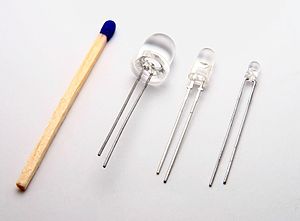
- Image via Wikipedia
For phosphor-based light-emitting diodes(LEDs) to continue their current trend of displacing incandescent and fluorescent bulbs, makers of these small semiconductor-based lights are looking to, among other things, continue improvements in energy efficiency, increase longevity and reduce glare.
LEDs are illuminated by the movement of electrons in a semiconductor material, but the common practice of coating the semiconductor with phosphors to produce white light is an impediment to potential improvements. With most phosphors, more than half of the photons generated divert back toward the semiconductor substrate called the die, where much of the light is absorbed and lost, says Nadarajah Narendran, director of research at Rensselaer Polytechnic Institute’s Lighting Research Center (LRC) in Troy, N.Y.
The avoid these problems, researchers have for several years experimented with ways of separating the phosphor from the underlying energy source. Such a layered configuration allows light traveling back toward the die to instead escape through the sides, generating 30 to 60 percent more light output (measured in lumens) and luminous efficacy (lumens per watt of electricity) than typical white LEDs, says Narendran, also a professor in Rensselaer’s School of Architecture, whose LRC research focus is LED performance, packaging and lighting application. “Phosphor is direction agnostic, so when you put the phosphor right on the chip, half the amount of light goes downward and half goes up,” he adds.








